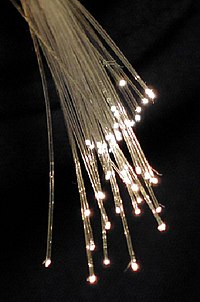
Photo from wikipedia
Since its early commercial deployment in the late 1980s, optical fiber has evolved to become the predominant carrier of the globe’s communications. Yet, after accommodating the world’s exponentially growing appetite… Click to show full abstract
Since its early commercial deployment in the late 1980s, optical fiber has evolved to become the predominant carrier of the globe’s communications. Yet, after accommodating the world’s exponentially growing appetite for transmitted data for more than three decades, its ability to continue doing so is being challenged by fundamental factors. In this article, we review these factors and examine their consequences in terms of information capacity. In particular, we review the difficulties that are imposed by the nonlinear nature of fiber-optic transmission on the assessment of the capacity and on the definition of fundamental concepts, such as bandwidth and spectral efficiency. We discuss relevant approximations and regimes of operation in which bounds for the capacity can be effectively assessed while covering a broad range of applications ranging from interdatacenter communications to links spanning transoceanic distances. We relate to a broad variety of transmission schemes and discuss the potential benefits of spatial multiplexing with multimode and multicore fibers. State-of-the-art transmission experiments are also reviewed and compared with theoretical capacity bounds.
Journal Title: Proceedings of the IEEE
Year Published: 2022
Link to full text (if available)
Share on Social Media: Sign Up to like & get
recommendations!